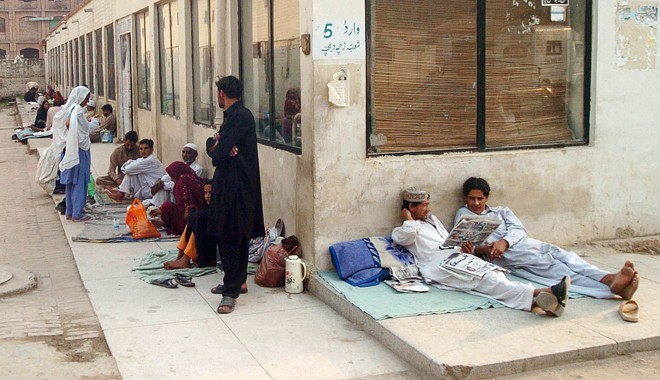

It is a fact that the number of attendants in public hospitals far exceeds that of the patients admitted in different wards. It is also a fact that these hospitals don’t have X-ray rooms, blood banks, collection centres and laboratories under the same roof, which is where the role of the patients’ attendants becomes active.
Mayo’s collection centres for blood and urine specimens, for instance, are housed in three different parts of the hospital premises and at a fair distance from the main wards. Similar is the case with the hospital labs and X-ray rooms.
Under the popular impression that in government hospitals the patients are not properly taken care of, the families and/or friends of indoor patients want to stay back with them. They are often found queuing at the pharmacy window with prescription slips or running around, inquiring about admission or address of different departments/sections of the hospital.
There are only two to three paramedics for a 20-bed ward and these paramedics can only be seen when a team of senior doctors is visiting.
The wards always have a shortage of nurses which forces the patients’ attendants to do the needful. Very often, the attendants have to perform chores such as detaching the drip bag from the branula. This is highly risky and the patient can start bleeding at the branula point.
Talking to TNS, AMS, Mayo Hospital, Dr Syed Ali Hassan says an average of 50,000 attendants are present in the hospital at any given point of time. "There are 4 to 5 attendants with a patient but this does not mean the hospital has no care for the patients.
"It’s more of a cultural thing," he adds. "Traditionally, our relatives like to visit the patient and sometimes even stay overnight in the hospital."
About the facilities for the attendants, the AMS says Mayo has a Musafir Khana (guest house) which is adequately equipped with beds, seating, fans and water-coolers.
Dr Hassan rejects the notion that the attendants are there to "sort of fill in for the lack of staff. It’s purely their own decision. They don’t want to leave their patient alone even in the ICU. They sometimes impose themselves on the staff which has no option but to give in."
The situation at Services Hospital is no different. Its Gynae department, labour rooms and wards are all located in one corner whereas the blood bank, labs, collection centres and X-ray rooms are spread variously around.
Furthermore, there are four Gynae units at Services and more than 400 patients are admitted here on a daily basis, which means if there are two attendants with a patient, you are dealing with almost 1,000 people at a time most of whom shall be occupying the hospital corridors.
Attendants based in the city usually take turns in staying with the patient. Those coming from outside the city cannot do so. They look for a proper lodging in the hospital. Unfortunately, except Mayo, there is not a single public hospital in Lahore that offers them a place to stay over. As a result, these poor people have to sleep in verandas, lawns and, sometimes, even on stairs. Those sleeping outside have no shelter from rain, cold or the scorching heat of the summer sun.
In the Gynae ward, only a female attendant is allowed to stay with the patient. The male escorts, in such cases, not wanting to leave their women back, stay over in the hospital -- again, adding to crowd.
Some of these attendants are seen putting up at the little mosques in the hospital premises, sometimes for a nap or to use the restrooms.
The patients get breakfast, lunch and dinner from the hospitals but their attendants depend on the canteens for food.
To quote a Labour Room in-charge who does not want to be named, "The fact that attendants are allowed in does not mean the whole family should storm the hospital."
According to Dr Muhammad Moazzam, Services Hospital AMS, "We don’t have the concept of health insurance. In developed countries, insurance companies cover a patient’s treatment. The patient’s attendants just hand him over to the hospital and it is the insurance company’s job to keep in touch with the hospital for the patient.
"If we have a health insurance policy, which the government plans to launch soon, the rush of the attendants [in the hospitals] would end."
Dr Moazzam says the hospital has a plan to demolish the present Gynae ward and build a new building. "Presently, Services has no space for separate rooms for the attendants."